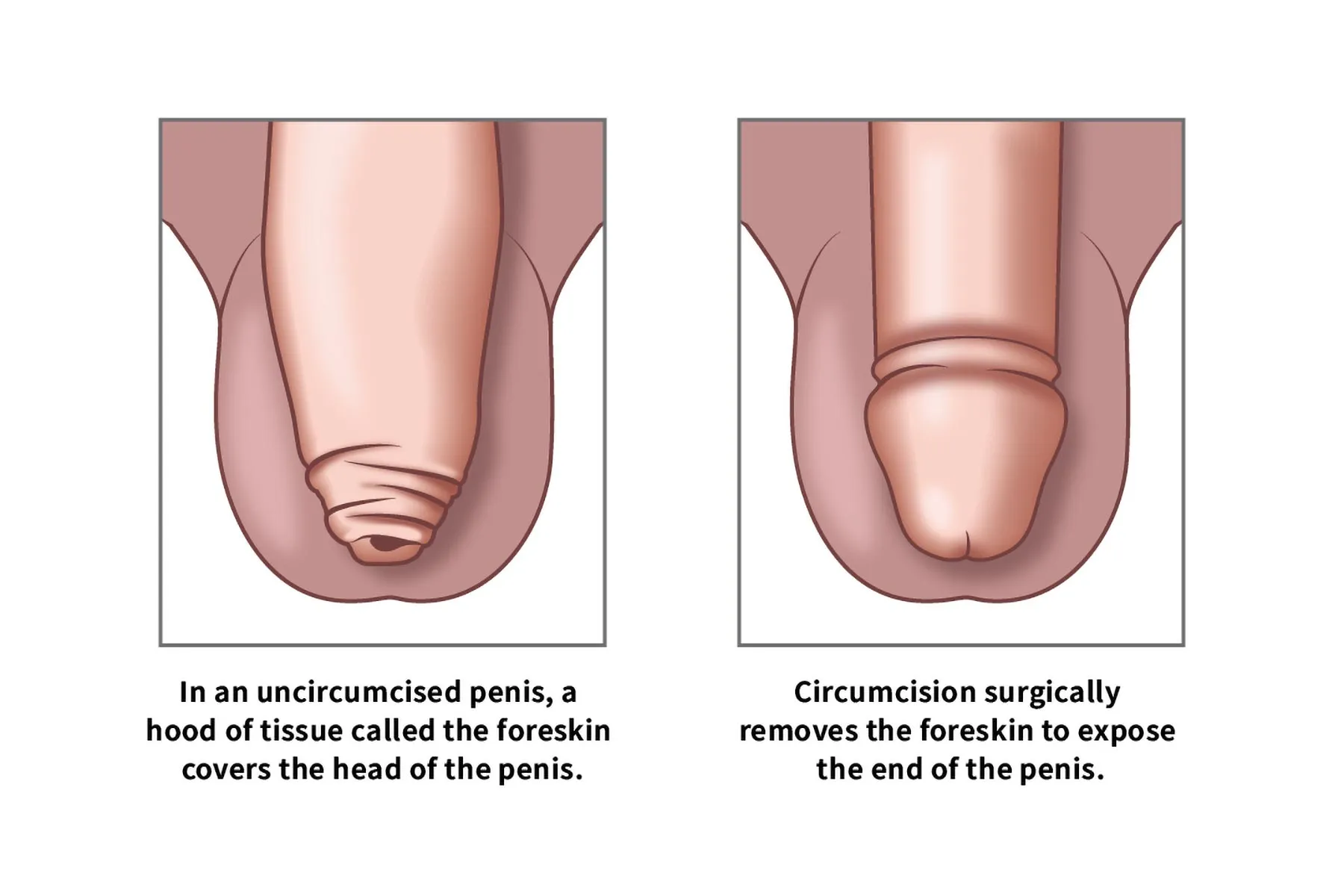What Is Circumcision?
Circumcision is the surgical removal of the foreskin, the tissue covering the head (called the glans) of the penis. It's an ancient practice that has its origin in religious rites. Today, many parents have their babies circumcised for religious or other reasons.
Circumcision is one of the most common surgeries done worldwide. In the United States, the rate of circumcision is up to 80%, while globally, it's about 38%.

Circumcised vs. Uncircumcised
An uncircumcised penis has a foreskin covering its head, while on a circumcised penis, the head is exposed. Research has shown there are no differences in how an uncircumcised penis and a circumcised penis respond to touch stimulation and orgasm. Similarly, circumcision doesn’t affect sexual function or fertility.
When Is Circumcision Done?
Circumcision is usually done on the first or second day after birth. (In Jewish tradition, circumcision is done on the eighth day.) The procedure becomes more complicated and riskier in older babies, children, and adults.
Reasons for Circumcision
Parents who circumcise their children often do so for religious or cultural reasons. The religions of Christianity, Islam, and Judaism require or recommend circumcision. Circumcision is also common in some parts of Africa, Australia, and the Middle East. Other reasons for circumcision include:
- Hygiene
- Preventing diseases such as urinary tract infections, sexually transmitted infections, and cancer
- Family reasons, like the father being circumcised
- Personal reasons
Parents who choose not to circumcise their children have reasons, including:
- It's not medically necessary
- Family reasons like the father being uncircumcised
- Fear of complications like bleeding and infection
- Concerns about the pain
- They believe it's their child's choice whether they want to be circumcised when they're older.
If you want your baby to be circumcised, talk with the doctor who will do the procedure and ask any questions you have about it. They'll explain the risks and benefits. If, after the chat with your doctor, you're sure you want your baby to be circumcised, you'll sign an informed consent form giving your permission for the surgery.
Circumcision Surgery
During a circumcision, the foreskin is cut from the head of the penis, and the excess tissue is clipped off.
The procedure is a bit different depending on the age at which it is done.
Newborn circumcision
Newborn circumcision is usually done by an obstetrician-gynecologist, a urologist, or a pediatrician. It most likely will happen in the hospital. Your child will be awake during the procedure. They’ll be placed on their back, with restraints to keep their arms and legs still.
The doctor will clean the penis area with antiseptic, then give the baby a numbing shot at the base of the penis to ease the pain. Sometimes doctors apply the pain reliever as a cream or give the baby pain medication. They’ll put a clamp or ring on the penis and remove the foreskin. A topical antibiotic ointment or petroleum jelly will then be put on the area, and it’s wrapped with gauze.
It’s usually over in about 10 minutes. Your doctor will recommend swaddling your baby after the procedure by wrapping them up tightly with a blanket or having them suck on a pacifier dipped in sugar water. If it’s done in the hospital, you should be ready to take your baby home in a few hours.
Jewish families may choose to have their child circumcised during a religious ceremony called a bris. That's normally done outside the hospital by someone with special training.
Adult circumcision
Circumcision can also be done in older children and adults. This surgery is usually done at a hospital by a urologist. Doctors may recommend it for health conditions involving the penis, like:
- Balanitis, which is inflammation of the head of the penis
- Balanoposthitis, which is inflammation of both the head and foreskin of the penis
- Cancerous or pre-cancerous growth on the foreskin
- Phimosis, a condition where the foreskin can't be pulled back from the head of the penis
- Paraphimosis, a condition where the foreskin can't be pulled forward into place over the head of the penis
- Posthitis, or inflammation of the foreskin
- Warts on the foreskin
Adult circumcision follows a similar procedure as newborns. But it's usually done under general anesthesia. After the foreskin is removed, you'll get stitches along the incision that will dissolve within about 10 days. Adult circumcision takes about an hour. It comes with a higher risk of complications than newborn circumcision, and recovery may take up to 3 weeks.
Types of circumcision
Circumcision is done through three main methods:
- Gomco clamp: This is the most common circumcision method for newborns. It uses a metal device with a cap to protect the head of the penis and a circular clamp that cuts off circulation to the foreskin to control bleeding while it's removed with a scalpel or scissors.
- The Plastibell technique: In this procedure, a doctor puts a plastic cap over the head of the penis, underneath the foreskin. Surgical thread is tied tightly around the foreskin, which cuts off circulation to the tissue and causes it to die. The cap is left in place until it falls off on its own after several days.
- Mogen clamp: This metal device was invented by a rabbi. It's similar to the Gomco method, except there's no cap to protect the head of the penis. The foreskin is stretched and clamped to control bleeding while it's removed with a scalpel.
Circumcision Surgery Follow-Up
After their circumcision, your baby may be fussy and irritable. Hold them carefully so you don’t put pressure on their penis. The tip may be sore. You may see a yellow crust on the tip as well. This is normal and should go away on its own in a few days.
Around 48 hours after the procedure, the bandage is usually not put back on once it comes off. Lubricant, though, should still be used to keep their penis from sticking to their diaper. If stool gets on their penis, gently wipe it away with warm, soapy water. To ward off infection, change their diaper often and fasten it loosely.
The circumcision generally heals in 5-7 days. Most of the time, babies recover without problems. Complications, like an infection, are rare. Contact your doctor if:
- Your baby doesn’t pee within 12 hours of the circumcision.
- You see blood on their diaper larger than the size of a quarter.
Older children or adults should take things slowly for 2-3 days. Rest, take pain meds and antibiotics as prescribed, and don't do any heavy lifting. Drink plenty of water and other clear fluids, especially in the first 24 hours after the procedure. Ice the area for up to 2 hours the first day, 10-20 minutes at a time. Wear loose, comfortable underwear and keep the dressing over the area until your doctor says to take it off.
Don't swim or take a bath for at least a week after the procedure. Avoid bike riding for at least 3 weeks and strenuous activities like running or lifting weights for 4-6 weeks.
Call the doctor right away if you have:
- Any trouble peeing
- A fever
- Any bleeding
- An unusual smell or discharge at the tip of the penis
- Blistering
If there’s a plastic ring instead of a gauze wrap, call the doctor if it stays on longer than 2 weeks.
Is Circumcision Necessary?
Experts still debate the benefits of circumcision for medical or health reasons. However, the American Academy of Pediatrics found that though the health benefits of newborn circumcision outweigh the risks, the benefits are not great enough to recommend it across the board.
Pros and Cons of Circumcision
Talk with your doctor about the benefits and risks of the procedure before deciding whether to circumcise your child. You can also consider culture, religion, and personal preference when choosing whether to circumcise your child.
Circumcision benefits
Evidence suggests that circumcision has health benefits, including:
- Less risk of urinary tract infections
- A lower risk of some sexually transmitted diseases
- Protection against cancer of the penis and a lower risk of cervical cancer in sex partners
- Prevention of balanitis (inflammation of the head of the penis) and balanoposthitis (inflammation of the foreskin and head of the penis)
- Prevention of phimosis (the inability to retract the foreskin) and paraphimosis (the inability to return the foreskin to its original location)
- Circumcision also makes it easier to keep the end of the penis clean.
Some studies show that good hygiene can help prevent certain problems with the penis, including infections and swelling, even if the penis isn't circumcised. In addition, using a condom during sex will help prevent STIs and other infections.
Circumcision Risks
Like any other surgical procedure, there are risks in getting circumcision. But this risk is low. Problems linked to circumcision include:
- Pain
- Risk of bleeding and infection at the site of the circumcision
- Irritation of the glans
- Higher chance of meatitis (inflammation of the opening of the penis)
- Risk of injury to the penis
Some people are opposed to circumcision because they consider it to be disfiguring.
Takeaways
Circumcision removes the foreskin from the head of the penis. It's one of the most common surgeries worldwide and is generally safe. It's done on newborns, older children, and adults for many reasons. If you're considering circumcision for your child or yourself, talk to your doctor about the risks and benefits.
Circumcision FAQs
What happens if a man is circumcised?
Circumcision changes how someone's penis looks and may lower their risk of diseases such as cancer of the penis, HIV, and HPV. Doctors say it has no effect on your sexual function or fertility.
What happens if you don't circumcise?
When they're old enough, you'll have to teach your child to pull back their foreskin and wash underneath it. As long as you keep the area clean and use condoms, being uncircumcised will make no difference in your genital health and overall quality of life.

